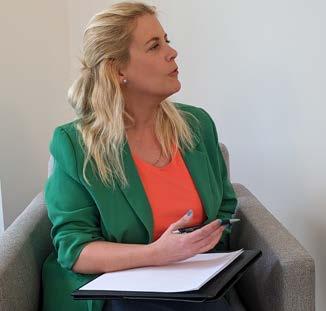PAPER: OUT TRANSFORMATION
enterprises that have had to drastically scale back their global indirect procurement function while having to remove a lot of associated processes and spreadsheets along with it. In both scenarios, it’s about making a change that is fit for the purpose of the department and the organisation.
So, where did dormakaba fit in on this spectrum?
Probably right in between. They had global procurement people fulfilling indirect procurement roles, but not really department leadership in indirect procurement. It was very isolated, and usually juggling indirect with direct responsibilities. In fact, when I first arrived in late 2022 it would have been quite difficult to even

DORMAKABA
Nina Bomberg
have teams meetings with everyone as they had very little in common or very little shared knowledge.
On the positive side, a lot of the people in those roles had been there less than three years, were keen to change, and certainly weren’t unaware of the challenge. And then, actually, it was like a mixand-match bikini where everyone offered a different experienced challenge, and we could cherry pick the best ideas and processes and discard the rest, to form the best plan for moving forward.
And we’ll certainly go into what that plan has
comprised. But, more generally, it sounds like this scenario for indirect procurement isn’t unusual? Do you see it as an undervalued or unloved department in general?
‘Undervalued’ is a relative term. It depends what it means to each organisation. In areas of engineering, for example, the scope and priority around direct procurement might push indirect into the background. Here at dormakaba though, the balance between the two is a lot more even, and so, therefore, is the value placed on it.
Let’s be honest, we are also
supposed to be the silent, hidden, smooth-running function enabling all parts of the business to run well. We don’t want to be talked about a lot because that would usually mean there is an issue. When we’re operating seamlessly that’s a good sign.
However, importantly, this doesn’t mean it should fall off the hitlist when looking at supply chain transformation or investment. We have a lot to offer when it comes to savings and value.
It’s the financial aspect that gets you noticed when banging the ‘change’ drum?

Profile DORMAKABA
The Business
I keep saying: ‘I can build up, or I can tear down, but I can’t just dust’. Three percent year-on-year gains, I’m not made for.

Of course! I can talk about processes and resources… but if I say, there’s an opportunity to save X million euros, heads pop up. That’s
my job to identify those possibilities to be more efficient and productive and ‘valuable’.
Just to reiterate though, our primary role is to enable functioning processes across a business. Whether I buy stationary for X or Y amount doesn’t matter much revenue-wise. But if we’re taking 30 minutes to purchase them instead of 15, then over a year that is a lot of time and money wasted.
Also, to confirm, it’s rarely the case that I’m brought into a business, I notice things aren’t as they told me they’d be, and I start advocating
for a transformation. I’m usually there because they’ve already had that lightbulb moment and have identified me to fix things.
It’s then my job to actually form a roadmap for change and to show where improvements and efficiencies lie.
So, from that point, there is a level of trust in you and your department, typically?
Yes, because there’s actually not that much of an overlap between direct and indirect procurement. Generally, there’s nobody who knows better than we do about the

5 DORMAKABA
department, so we provide the information, we’re given targets, and we then work – largely – independently to achieve those targets in the best way.
And that is also when it’s my job to advocate for new processes, structures, technologies, etc, that would help me in realising the company’s objectives for our department. Other than that, we’re largely left to our own devices.
Okay, so taking into account the general supply chain strains of the past few years, does that mean you’ve not been included in those big transformation conversations?
It depends. I’m usually saying from minute one that we do need to be part of the conversation, especially when it comes to digital investments and IT tools, for example. Here, I can make the case of using indirect procurement as a bit of a prototype for new solutions, because – trust me – if it can work in indirect, then direct will be a walk in the park.
always as clear. With direct procurement you can plot the lifecycle of every part or component or material. There is a clear outcome every procured item is lending towards. That’s not the case with indirect procurement. We’re a constantly rolling function with a lot of items ‘unclassified’, for want of a better word. That’s not ideal for analytics and data management. So, that’s a very specific indirect challenge that can set the better solutions apart from the competition.
That is quite a high-level challenge of course, though.
So, there’s more recurring day-to-day tech challenges that you face in indirect procurement?
I’d say it goes back to that element of ‘value’, this time being placed on our time.
That’s why I’m a big advocate for encouraging digital transformation in a way that elevates what we actually do. Right now, this is seen through a machine learning solution that, when we want to buy a pencil, there is a direct link to a catalogue for our requestors. Seamless!
It’s the same for more rare items too, though, like maybe an acoustics wall. Those providers won’t be so familiar but will all be loaded into this tool, channelling our team towards a seamless process of getting a quote, and seeing through the entire process much more quickly.
We have different requirements and it’s not
You’ve got 100 apps on your phone, say… how many of those did you need training on? Probably none. We’re all experienced people living in a digital world. And yet every prospective new solution comes with hours of training, so that we can apparently better buy a pencil or toilet paper. It’s not relative.
Remember, indirect procurement also spans the need for maybe a plumber or something like that too. Anything that enables the business to function, we need access to, and this level of automation to help find the best provider for what is needed in real-time, is what I’d call fit for purpose.
Has there been a lot of disruption to accumulate and integrate the information needed to fill this tool?
Nowhere near as long as I’d have thought. It’s quite
Business Profile DORMAKABA
The

7 DORMAKABA www.BusinessSocial.org
incredible. We’ve worked with AslLio to set this all up and actually it’s been developed and readied quicker than our internal approvals processes can manage. But the trial was set up in a week. Pivotally, the solution understood the different formats of data that were being brought together, which is typically a huge hurdle when integrating new IT systems and bringing together large swathes of data.
And this is just the tip of the iceberg, tech wise. We are also in the process of implementing Ariba and already have in some areas. We do have to be careful though, as we always have to be mindful of our vendors and business partners. If we’re making their lives more difficult, they will not move everything to make things work for us. They won’t necessarily move to a new platform just because it suits us, if it means a big overhaul for them.
So, while we are enjoying very good momentum with our digital transformations of late, we do have our own bottlenecks in indirect procurement to be mindful of.
I’m presuming you’ve had great buy-in from your own team? They’re onboard with reasons for change?
Yes, totally. With every change management project the biggest problem is if the people involved don’t understand why it’s happening. If they don’t see the benefit of a change, why would they change, individually? Why would they engage with it?
When I say ‘people’, that’s not just my team either. It is decision makers across the organisation, seeing how we as a department are changing and why we needed to. It could be because you’re bleeding money, wasting time, causing yourself regulatory headaches, threatening security, annoying customers or business partners… it’s often the financial benefits that grab the attention of peers of course, but all the reasons need to be clear as there will be different priorities for different people.
There are clearly plenty of areas to find small improvements?
that, the improvements can be quick and relatively easy to attain. Yes, we are not usually the biggest department, but that brings agility, quicker alignment of thought and team strategy, and quicker integration of new solutions and ideas. If you have the agility to enact lots of small changes, then they soon add up to a lot of quick wins, which is good financially, for team moral, and for the shareholders of course.
Looking at your time at dormakaba so far, what has been the biggest of those wins?
To go back to one of your earlier comments, too,
Absolutely, but not only
I would say the directive put in place after I arrived. It laid the foundations and gave us a mandate to work towards everything else. It stopped debates around what areas we should or shouldn’t be involved with and allowed us to formulate a clearer mission and strategy that we could deliver on for the benefit of the organisation. It confirmed what the company needed from us, what we could deliver, what we should change to deliver more, and what indirect procurement’s potential is at the other side of those changes.
9 DORMAKABA

I’m a big advocate for encouraging digital transformation in a way that elevates what we actually do. Right now, this is seen through a machine learning solution that, when we want to buy a pencil, there is a direct link to a catalogue for our requestors. Seamless!
The Business Profile
There is even a risk that, in indirect procurement, we’ve become too homogenous. We could come up with our vision and mission statement in about 45 minutes, so we do joke we need to be careful not to form an echo chamber. But in all seriousness that was just a reflection of us all aligning on how to be a better business partner, to be more resilient as part of the supply chain, and how to unlock faster and easier processes. It’s hard not to align on those kinds of things.
It’s not like the missions were easy to accomplish, either?
Certainly not. We’re talking about big business projects here, and we’ve set expectations high.
It involves changing our SAP landscape, moving over to Hana like everybody else, implementing Ariba, and also leveraging the rollout of our new machine learning categorisation solution. None of it is simple as we’re a company that has evolved through mergers and acquisitions, resulting in as many as 78 different ERP systems alone, running across the company. If
you ever want to run a benchmark, honestly just come and talk to us. We know them all.
What’s the vision moving forward then, having already embarked on quite a big period of change?
It’s to retain a culture that is agile to change. We’re lucky in indirect procurement, and especially here where the global team all reports into me. We can discuss something on a Tuesday, roll it out on the Wednesday and feel the benefits by Thursday. We have a common mission, a shared series of objectives, and the landscape doesn’t really differ significantly from region to region or office to office. Our purpose remains consistent. That’s obviously not the case in direct procurement with different customer needs also playing a huge part, and compliance much more of a bottleneck for materials and components.
This again helps us align on ideas, and generates great levels of buy-in from everyone. We all believe in what we’re doing, the changes we’re seeing and the goals we’ve set.
So, in terms of advice to other organisations yet to ‘love’ or ‘value’ indirect procurement the way they should…?
Just think about what there is to gain. If you can spare 3%, 4%, 5% of your spend then good for you. But I’m guessing you can’t and good luck explaining that to your shareholders, too. It might not be the biggest portion of your business, but it’s still money that’s essentially being left on the table when companies choose not to invest in a more efficient and productive indirect procurement function.
11 DORMAKABA
For enquiries email info@BusinessSocial.org MAGAZINE







